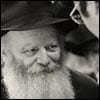Marc Asnin is a tough-speaking, sturdy New Yorker whose external roughness belies the artist’s eye that made him a serial award-winning photographer.
Throughout his professional career, he has taken shots for major media outlets like Life, The New Yorker, The New York Times Magazine, French Geo, La Repubblica, Le Monde and Stern.
On Sept. 11, 2001, Asnin was sent by Time magazine to Lower Manhattan to document the burning World Trade Center. “I arrived at the North Tower after the South Tower had fallen. I was under a fire truck for a few minutes with a fireman whose face I never even saw. Then I scoured ground zero for a few hours, looking for my assistant,” who he eventually found.
He says he felt so fortunate—so blessed—to make it home that day that he wanted to thank G‑d, and show his faith and bond with fellow Jews. “From that day on, I began covering my head wherever I go,” says Asnin, who often sports a crocheted black beanie. He also wears tzitzit, a small garment with biblically mandated fringes, under his shirt.
During the course of his life, he says he has been profoundly influenced by two Jewish men: His gangster uncle, Charlie Henschke, and the Lubavitcher Rebbe, Rabbi Menachem M. Schneerson, of righteous memory. Both men lived just a few blocks from one another in Brooklyn, N.Y., but inhabited universes that were light years away.
“Uncle Charlie grew up a gangster. His father was a Jewish gangster. Uncle Charlie would tell me about how his Judaism was robbed from him. There was money set aside for his bar mitzvah, but his parents took it to buy a used television. He felt bad about it.”
A First Encounter With the Rebbe
Asnin first encountered the Rebbe in 1988. “I had been photographing the Cuban Jewish community, and the head of the community needed to come to New York to get supplies for the Jewish school in Havana,” relates Asnin. “I took him to the address he gave me, 770 Eastern Parkway, and I realized that the people we were going to meet were Chassidim. At that time, they were all the same to me. Well, the Rebbe was standing there distributing coins to children to give to charity. Eventually, we found the Argentinian rabbi we were looking for, and that was that.”

In the winter of 1992, while working with The New York Times Magazine, he was assigned to photograph the 89-year-old Rebbe for a cover story on the Rebbe’s influence that extended far beyond his Brooklyn neighborhood to the world at large, from average people in need of personal advice, to world leaders seeking his counsel on geopolitical affairs.
Asnin recalls his surprise at how approachable the Rebbe was. "I had photographed lots of famous people, and most of them don’t let you get close. But the Rebbe had no problem with me staying up close,” says Asnin. While the Rebbe met thousands of people who lined up to spend a brief moment of personal blessing and at times consultation with him, Asnin stood close to document the Rebbe’s interactions.
"When you looked in his eyes . . . he was just very intense," Asnin remembers. "There was a different energy flowing from him. It was not the average interaction. It was the most special assignment I've ever had."

In 1998, as the 20th century was drawing to a close, Asnin’s photograph of the Rebbe was selected by The New York Times Magazine as one of the “25 Most Memorable Covers” of the previous 100 years.
As to the overall atmosphere at “770,” as the Eastern Parkway synagogue and center are widely known, Asnin says he “was amazed at how relaxed and easy everything was. By then, I had pretty much written off synagogue attendance as stuffy and oppressive, but this was something different, fluid and human. I had never felt welcomed at synagogue, but the people at 770 genuinely welcomed me. It was overwhelming but enthralling, and I kept on thinking, ‘Wow, this is incredible!’” As a result, Asnin maintained a close connection with some of the Chabad-Lubavitch rabbis he had met.
Keeping Up With Charlie
In addition to his many assignments, Asnin continued photographing his Uncle Charlie in the rough-and-tumble Bedford-Stuyvesant neighborhood of Brooklyn—a project that would span three decades, recalls Asnin, who was recently awarded the 2013 Robert F. Kennedy Journalism Award for his book “Uncle Charlie.”

“Over the years,” Asnin says, “my perception of my uncle changed.” At first, says Asnin, “he was my godfather, and I looked up to him. But he did some pretty bad stuff, committing crimes to get ahead. He struggled with mental illness, drug addiction, and strained relationships with his former wives and his children.”
With an attitude that changed from admiration to sympathy, Asnin eventually convinced Charlie to go with him to 770 to celebrate the bar mitzvah he had missed in childhood. He told him it was “a one-time thing,” and his uncle relented.
Once there, Charlie was offered a borrowed set of tallit and tefillin. “He did not even know what they were at first,” recalls Asnin. “But when he finally put them on, it made him so happy. He is normally pretty tense and always in a rush, but there, he was happy. It was like he finally got back the bar mitzvah that was stolen from him.”
Still, says Asnin, “he was all tattooed up; most people in society wouldn’t go near him. Only the Rebbe and his followers would have embraced him.”
“Being friends with rabbis like that really influenced me, and it influenced my friends as well,” he continues. “They are so surprised by how humble and nice the rabbis are. I know that the rabbis probably wouldn’t think of themselves as progressive, but they really are. The Rebbe was progressive, reaching out to everyone.”
‘The Deeper Story’
Asnin says the inspiration for his next project after the 2008 terror attacks in Mumbai, India, when Rabbi Gavriel and Rivkah Holtzberg were murdered in their Chabad house with four of their guests, Asnin was sent to chronicle the carnage. He recalled a quote about how “the Rebbe searched out every Jew in love, as they had once been searched out and hunted down in hate,” and that motivated him to embark on a new project of his own.
As a tribute to the Holtzberg’s memory, he decided to take pictures of Chabad’s wide-reaching influence on world Jewry in every continent.

“The Rebbe was a real revolutionary,” he explains. “He did not just sit back and watch the Diaspora crumble. You see his commitment through the commitment of the shluchim. The shaliach in Dagestan who was recently shot [Rabbi Ovadia Isakov] said that he is going back to serve his community.”
Asnin’s focus is on the diverse group of people touched by Chabad all over the world. “Wherever you go, they are there knocking up mezuzahs on doors and helping people into tefillin, but there is more to the story. The deeper story is that they are embracing all kinds of people.”

“I have been to prisons with Chabad rabbis all over the world—in Moscow, in Florida and in a women’s prison in New York. I photographed and interviewed some teenage girls who come from a horribly abusive house. The Chabad rabbi and his wife took them in to their home. I don’t know many people who would do that.”
Asnin plans to publish a collection of the photographs he has taken during his time with Chabad. The 1,000-page work will likely fill two volumes with photographs and text: one on Eurasia and the other on the Americas. The books, to be titled “A Light Among the Nations,” are a collaborative effort with editorial director Josh Herman, who has been traveling with Asnin and writing the text to accompany the photographs. The two have created a web site, www.alightamongthenations.com, to accompany the project.









Join the Discussion